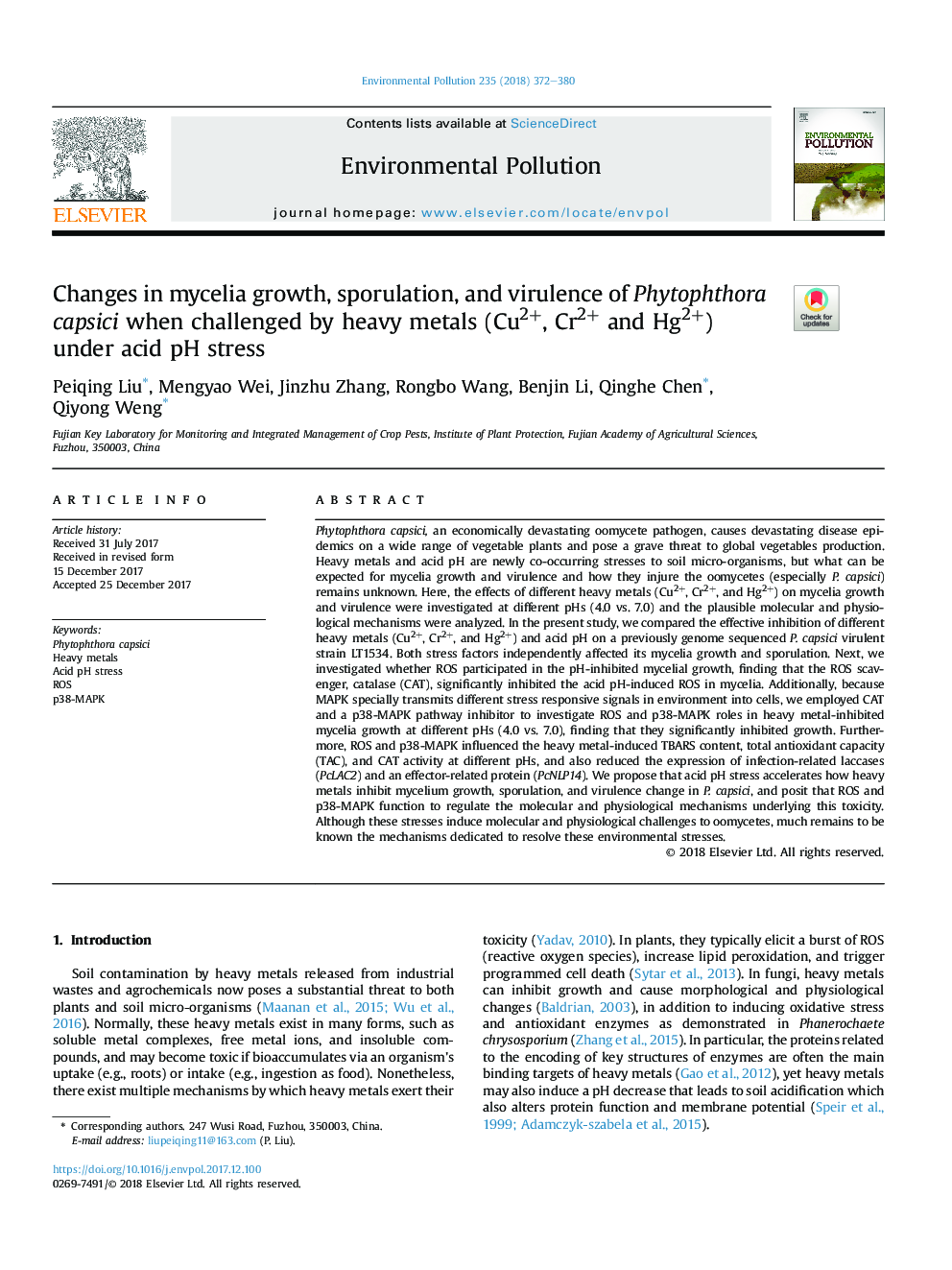| کد مقاله | کد نشریه | سال انتشار | مقاله انگلیسی | نسخه تمام متن |
|---|---|---|---|---|
| 8857207 | 1619137 | 2018 | 9 صفحه PDF | دانلود رایگان |
عنوان انگلیسی مقاله ISI
Changes in mycelia growth, sporulation, and virulence of Phytophthora capsici when challenged by heavy metals (Cu2+, Cr2+ and Hg2+) under acid pH stress
دانلود مقاله + سفارش ترجمه
دانلود مقاله ISI انگلیسی
رایگان برای ایرانیان
موضوعات مرتبط
علوم زیستی و بیوفناوری
علوم محیط زیست
شیمی زیست محیطی
پیش نمایش صفحه اول مقاله

چکیده انگلیسی
Phytophthora capsici, an economically devastating oomycete pathogen, causes devastating disease epidemics on a wide range of vegetable plants and pose a grave threat to global vegetables production. Heavy metals and acid pH are newly co-occurring stresses to soil micro-organisms, but what can be expected for mycelia growth and virulence and how they injure the oomycetes (especially P. capsici) remains unknown. Here, the effects of different heavy metals (Cu2+, Cr2+, and Hg2+) on mycelia growth and virulence were investigated at different pHs (4.0 vs. 7.0) and the plausible molecular and physiological mechanisms were analyzed. In the present study, we compared the effective inhibition of different heavy metals (Cu2+, Cr2+, and Hg2+) and acid pH on a previously genome sequenced P. capsici virulent strain LT1534. Both stress factors independently affected its mycelia growth and sporulation. Next, we investigated whether ROS participated in the pH-inhibited mycelial growth, finding that the ROS scavenger, catalase (CAT), significantly inhibited the acid pH-induced ROS in mycelia. Additionally, because MAPK specially transmits different stress responsive signals in environment into cells, we employed CAT and a p38-MAPK pathway inhibitor to investigate ROS and p38-MAPK roles in heavy metal-inhibited mycelia growth at different pHs (4.0 vs. 7.0), finding that they significantly inhibited growth. Furthermore, ROS and p38-MAPK influenced the heavy metal-induced TBARS content, total antioxidant capacity (TAC), and CAT activity at different pHs, and also reduced the expression of infection-related laccases (PcLAC2) and an effector-related protein (PcNLP14). We propose that acid pH stress accelerates how heavy metals inhibit mycelium growth, sporulation, and virulence change in P. capsici, and posit that ROS and p38-MAPK function to regulate the molecular and physiological mechanisms underlying this toxicity. Although these stresses induce molecular and physiological challenges to oomycetes, much remains to be known the mechanisms dedicated to resolve these environmental stresses.
ناشر
Database: Elsevier - ScienceDirect (ساینس دایرکت)
Journal: Environmental Pollution - Volume 235, April 2018, Pages 372-380
Journal: Environmental Pollution - Volume 235, April 2018, Pages 372-380
نویسندگان
Peiqing Liu, Mengyao Wei, Jinzhu Zhang, Rongbo Wang, Benjin Li, Qinghe Chen, Qiyong Weng,